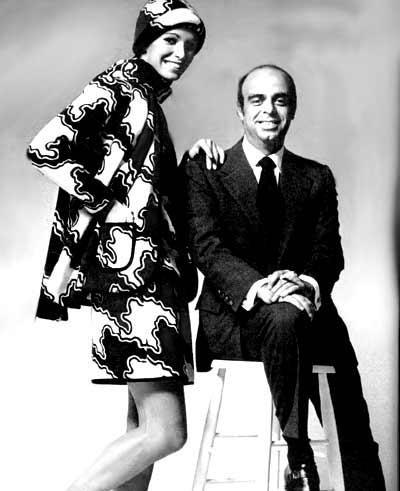
Donald Marc Blumberg
About
Donald Brooks was an American fashion designer.
Born Donald Marc Blumberg in 1928, in New Haven, Connecticut, Brooks attended Syracuse University followed by the Yale School of Drama, where he first decided to become a costume and clothing designer. He studied design at the Fashion Institute of Technology and then the Parsons School of Design in New York. There he graduated in 1950. After leaving Parsons, he began his career as a sketch artist and window dresser for such stores as Lord and Taylor. He attracted the attention of Dorothy Shaver, the store's president, who hired him to design a clothing line that year.
At the same time, he started working for the first of many ready-to-wear companies whom he joined during the 1950's culminating wioth a position at Townley Frocks, run by Claire McCardell. In 1958, when Claire McCardell died, Donald Brooks took over the designing for her Townley Frocks label as well as under his own label and in the early 1960's he also began working as a costume designer for films and the stage.
In 1962 while still at Townley, Brooks designed an Empire-waisted dress in hot pink silk shantung. The dress is shown here on the left. Mrs Kennedy wore it on a tour of India in 1962, when she took a cruise on the river Ganges.
By the 1960s, Brooks was a preeminent figure in American fashion, cited by the New York Times as one of “the three B's of fashion” alongside Bill Blass and Geoffrey Beane. He opened his first store in 1963.
From 1961 he has been a designer for theatre, film, and TV custom clothing. His first broadway show "No Strings" in 1963 won a Drama Critics Award. The actress Julie Andrews had a preference for his costumes. His plays include "Barefoot in the Park" in 1962 and his films include "The Cardinal" in 1963, "the Third Day" in 1965, "Star" in 1968, "Darling Lili" in 1970, "The Drowning Pool" in 1975 and "The Bell Jar" in 1979.
He won three Oscar nominations for costume design in films. He also won an Emmy for his costumes in the TV film "the Letter" in 1982.
Brooks has costumed nearly 30 Broadway shows including "On a Clear Day you can see Forever" in 1965 and "The Last of the Red Hot Lovers" in 1969.
Brooks was awarded the Coty American Fashion Award in the years 1958, 1962, 1967 and 1974. He was also awarded the Parsons Medal for Distinguished Achievement in 1974. This medal has only been awarded a few times in the century to such great designers as Adrian, Norell and McCardell. Brooks was also awarded an Emmy Award in 1982.
Brooks had a low-key chic often relying on striking prints and fabrics. One horizontally striped wool dress incorporated 70 colours.
In 1980 Brooks introduced his DB II line, and Ready-to-Wear in 1986. From 1990 he has been a consultant for fabric and colour design for the Ann Taylor Stores.
At the age of 75 he stepped out to attend the opening in October 2003 of a retrospective exhibition called "Donald Brooks : An American Original" held in New York. He was a founding member of the Council of Fashion Designers of America, and all his fashion designer friends and a great many of his famous clientele attended. Dozens of dazzling evening gowns and dresses have been lent by the Metropolitan Museum, the Smithsonian, Private collections and ladies who have worn his gowns, to appear at the Exhibition.
He died in New York in August 2005 at the age of 77.
The Look
Donald Brooks is recognized for his promotion of the chemise and his creation of simple, unadorned dresses, trimmed coats and stoles. He let the fabrics speak for the subtlety of the silhouettes. Staying power characterized Donald Brooks every bit as much as the simply cut, easy fitting dresses in distinctive fabrics for which he is best known. By the mid-1960s, Brooks was one of the few American designers to have financial control of his own business. From that base he diversified along the usual lines, designing sweaters, shoes, swimsuits, furnishing fabrics, and other items under a multitude of licensing agreements. Brooks' clothes were known for their clean lines, often surprising colors, and for their distinctive fabrics, most of which he himself designed. There is a boldness about a Brooks design that makes an impact and makes his contemporary dresses for the stage particularly successful.
Who Wears It
Jackie Kennedy